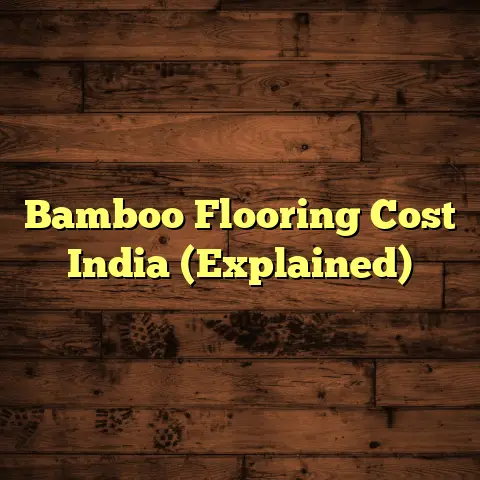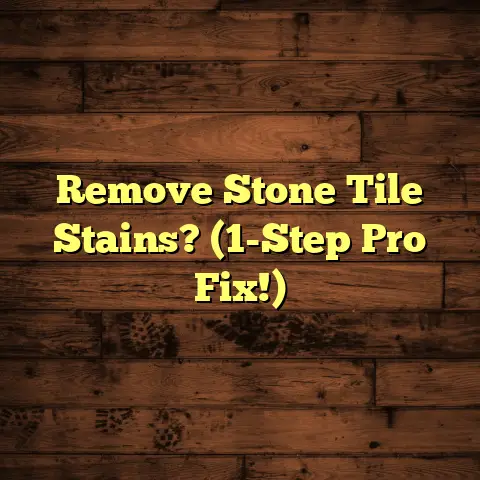Is Marble Flooring Expensive? (2 Hidden Costs!)
I’ll never forget the first time I truly appreciated marble.
It wasn’t in some fancy showroom, but in my Aunt Maria’s house.
Stepping into her foyer was like entering a different world.
The cool, polished marble floor gleamed under the sunlight, inviting you further inside.
I remember tracing the intricate veining with my fingers, marveling at the patterns.
It felt timeless, elegant, and undeniably luxurious.
That feeling stuck with me, and it’s why I understand the allure of marble flooring.
But let’s be real, that luxury comes at a price.
And it’s not just the initial price tag you see at the flooring store.
I’m here to pull back the curtain and talk about the real costs of marble, including those sneaky hidden expenses that can blindside you.
1. Introduction to Marble Flooring
Marble. The very word evokes images of grand palaces, ancient sculptures, and sophisticated homes.
It’s been used in architecture for centuries, a testament to its beauty and durability.
But is it right for your home?
That’s what we’re here to find out.
While marble offers undeniable aesthetic appeal, it’s crucial to understand the full financial picture before taking the plunge.
This isn’t just about the upfront cost; it’s about the long-term investment and the potential hidden expenses that can creep up on you.
2. Section 1: The Initial Cost of Marble Flooring
Let’s get down to brass tacks.
How much does marble actually cost?
Generally, you’re looking at a price range of \$5 to \$20+ per square foot for the material alone. (Source: HomeAdvisor).
Yes, that’s a wide range, and for good reason.
The price fluctuates based on several factors:
- Quality: Higher grades of marble with fewer imperfections will naturally cost more.
- Type of Marble: Carrara, Calacatta, Statuario – each type has its own unique characteristics and price point.
- Rarity: Some colors like blue are hard to find and will cost you more.
- Region: Sourcing marble from Italy, for example, may be more expensive than marble quarried locally.
- Thickness: Thicker slabs or tiles are more expensive.
How does marble stack up against other popular flooring options?
Here’s a quick comparison:
| Flooring Type | Price per Square Foot (Material Only) |
|---|---|
| Marble | \$5 – \$20+ |
| Hardwood | \$3 – \$12 |
| Tile | \$2 – \$15 |
| Laminate | \$1 – \$5 |
As you can see, marble is generally more expensive than laminate and often on par with, or more expensive than, hardwood and tile.
Keep in mind this is just the material cost.
We haven’t even factored in installation yet!
3. Section 2: Installation Costs
Think you can slap down some marble tiles yourself and save a few bucks?
Think again.
Marble installation is not a DIY project for the faint of heart.
I’ve seen too many botched attempts that ended up costing homeowners even more in the long run.
Why is it so complicated?
- Subfloor Preparation: Marble requires a perfectly level and stable subfloor. Any imperfections can lead to cracking and unevenness.
- Cutting and Shaping: Marble is a natural stone, and cutting it requires specialized tools and expertise.
- Mortar and Grout: Choosing the right mortar and grout is crucial for preventing staining and ensuring a strong bond.
- Weight: Marble is heavy! Handling and maneuvering large slabs or tiles can be challenging and potentially dangerous.
Labor costs for marble installation can range from \$3 to \$8 per square foot or more, depending on the complexity of the job.
(Source: Fixr.com).
That’s on top of the material cost!
Hiring a skilled professional is essential.
Look for someone with experience specifically in marble installation.
Ask for references, check their portfolio, and make sure they are licensed and insured.
Trust me, the peace of mind is worth the extra investment.
4. Section 3: Hidden Cost #1 – Maintenance and Upkeep
Okay, you’ve installed your gorgeous marble floor.
Time to sit back and enjoy it, right?
Not so fast.
Marble is a high-maintenance material.
It requires regular cleaning and sealing to keep it looking its best.
And that’s where the first hidden cost comes in: ongoing maintenance.
- Cleaning: Marble is porous, meaning it can easily absorb spills and stains. You need to clean it regularly with pH-neutral cleaners specifically designed for natural stone. Avoid harsh chemicals, acidic cleaners, and abrasive scrubbers, as these can damage the surface.
- Sealing: Sealing helps to protect the marble from stains and moisture. You’ll need to reseal your marble floor every 1-2 years, depending on the traffic and usage.
- Polishing: Over time, marble can lose its shine. Professional polishing can restore its luster, but this can be an expensive service.
The susceptibility of marble to scratches, stains, and etching is a major concern.
Anything acidic, like lemon juice or vinegar, can etch the surface, leaving a dull mark.
Even water can leave spots if not wiped up promptly.
Specialized cleaning products can cost \$15-\$30 a bottle, and professional cleaning services can range from \$100-\$500 per visit, depending on the size of the area. (Source: Thumbtack).
These costs add up over time, so it’s important to factor them into your budget.
5. Section 4: Hidden Cost #2 – Repair and Replacement
Accidents happen.
A dropped pot, a dragged piece of furniture, a rogue high heel – all can lead to chips, cracks, and scratches in your marble floor.
And that’s where the second hidden cost rears its ugly head: repair and replacement.
Repairing damaged marble can be tricky.
Minor scratches can often be buffed out, but deeper scratches and chips may require professional repair.
Replacing individual tiles can be even more challenging.
Finding a perfect match for the existing marble can be difficult, especially if it’s a rare or discontinued type.
Even if you find a close match, the new tile may not blend seamlessly with the surrounding tiles due to variations in color and veining.
Replacing an entire section of flooring may be necessary to ensure a consistent look, which can be a significant expense.
The cost of repairing or replacing marble flooring can range from \$200 to \$1000 or more, depending on the extent of the damage and the complexity of the repair. (Source: Angi).
Preventive measures are key to minimizing the risk of damage.
Use rugs and mats in high-traffic areas.
Avoid dragging furniture across the floor.
And be extra careful with acidic substances.
6. Section 5: Long-term Value of Marble Flooring
Okay, so marble is expensive and high-maintenance.
Is it really worth it?
That’s the million-dollar question.
While the initial investment may be substantial, marble flooring can add significant value to your home.
It’s a timeless and elegant material that can enhance the aesthetic appeal of any space.
In terms of ROI (Return on Investment), marble can increase your property value, especially if it’s well-maintained and complements the overall design of your home.
A well-maintained marble floor is a statement of luxury.
I’ve seen homes with marble floors sell for a premium compared to similar homes with less upscale flooring.
But it’s not just about the financial return.
Marble can also create a sense of pride and enjoyment in your home.
It’s a material that you can appreciate every day, and it can be a source of conversation and admiration for guests.
I once worked with a homeowner who installed marble flooring in her entryway.
She told me that it completely transformed the feel of her home, making it feel more welcoming and sophisticated.
She said it was the best investment she ever made.
7. Section 6: Environmental Impact and Sustainability
Before you rush out to buy a truckload of marble, let’s talk about the environmental impact.
Quarrying marble can have a significant impact on the environment, from habitat destruction to water pollution.
It’s important to be aware of these issues and to make informed choices.
Look for marble that is sourced from sustainable quarries that follow responsible mining practices.
Some companies are also exploring innovative ways to recycle and reuse marble waste.
Another option is to consider alternatives to traditional marble, such as engineered stone or recycled glass tiles.
These materials can offer a similar look and feel to marble while being more environmentally friendly.
Finding the balance between luxury and environmental responsibility is a challenge, but it’s one that we all need to consider.
8. Conclusion
So, is marble flooring expensive?
The answer is a resounding yes.
But it’s not just the initial price tag that you need to worry about.
The hidden costs of maintenance and repair can add significantly to the overall expense.
However, marble is also a beautiful and durable material that can add value to your home and enhance your quality of life.
Ultimately, the decision of whether or not to invest in marble flooring is a personal one.
Weigh the costs and benefits carefully.
Consider your budget, your lifestyle, and your long-term goals.
And remember, a little bit of knowledge can go a long way in making the right choice for your home.
Now, I’m curious…
If you could have any type of flooring in your dream home, what would it be and why?





